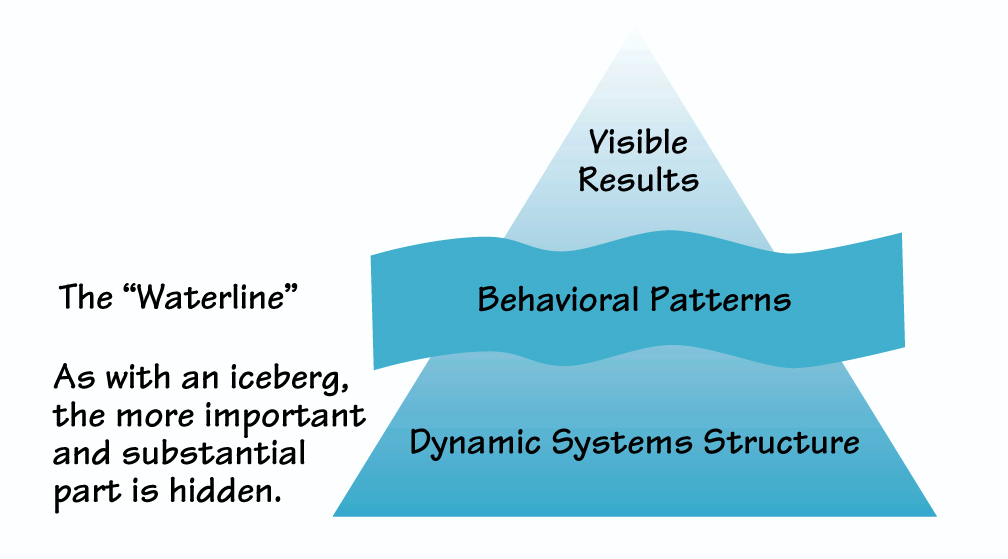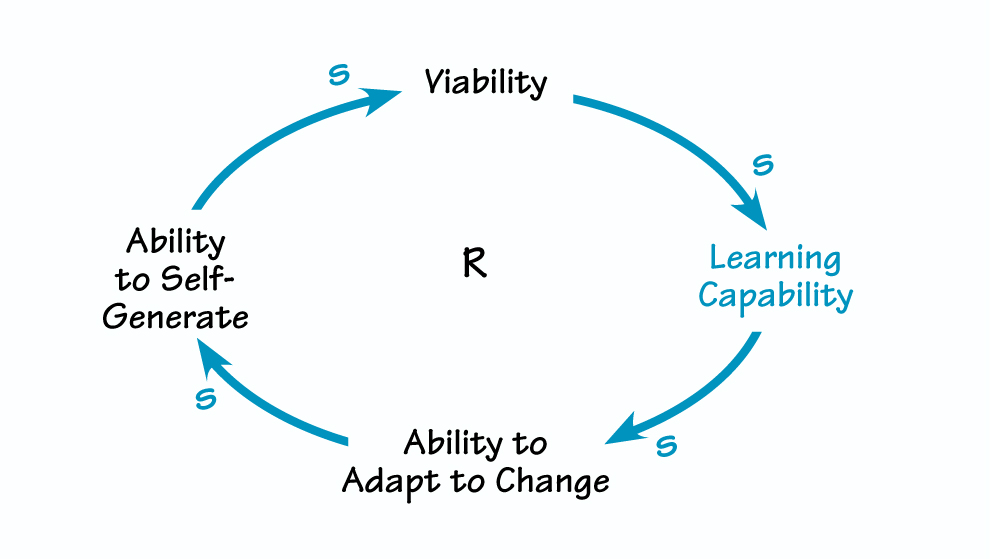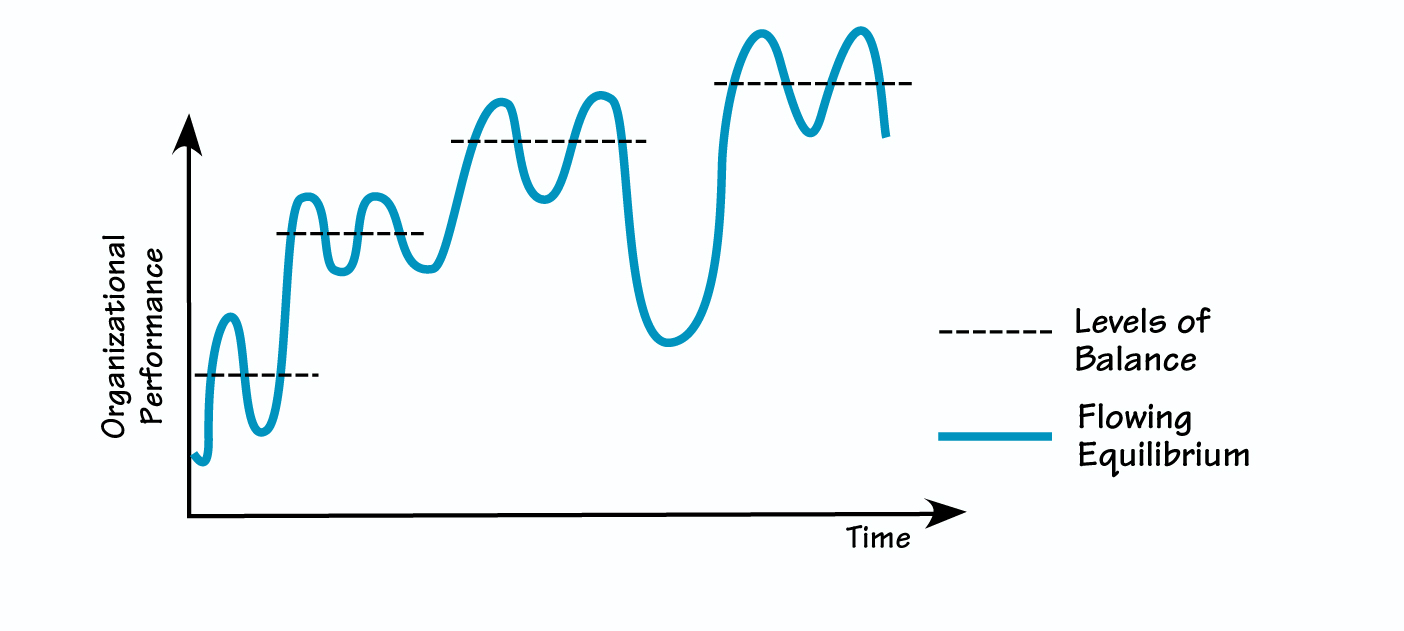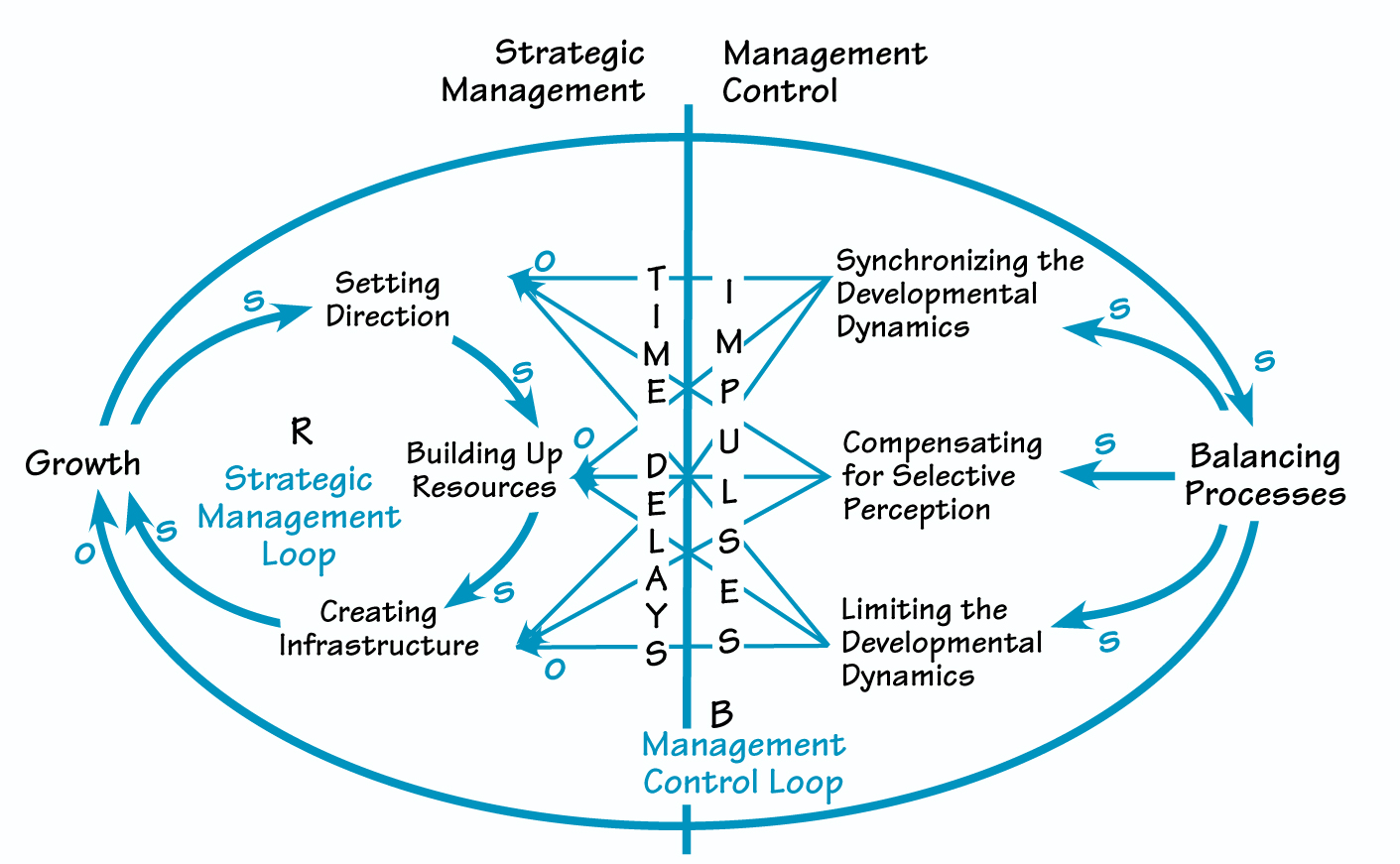Why do some companies grow while others shrink? Why are some firms extraordinarily successful over the years while others even those in the same industry slide from crisis to crisis? Why do so many brilliant management strategies lead firms directly into decline or not produce the anticipated results? And why do so many classical theories of business administration fail to explain these phenomena and help company leaders avoid or overcome these problems?
Executives today are constantly seeking to predict how their organizations and the marketplace will behave. But because many leaders continue to use traditional reductionist methods to understand organizational behavior ones that focus more on symptoms than on causes of a company’s success they fail to gain real insight into how to build and sustain that success. The result is often reactive, crisis driven management with unanticipated side effects and unforeseen outcomes.
Contrary to this rigid perception of organizations as predictable machines, some management thinkers have come to view them as complex and evolving organisms. Accordingly, the tendency in the business world to define companies in terms of simple formulas and numerical results is slowly being replaced by the recognition that, to be effective in leading organizations, we must think of them in terms of the underlying structures and dynamic patterns of behavior that produce those results. In other words, we must begin to complement or replace linear thinking about how our businesses work with nonlinear approaches by applying the principles and tools of system dynamics.
System Dynamics Theory
Why do so many brilliant management strategies lead firms directly into decline or not produce the anticipated results?
In his classic 1961 book Industrial Dynamics, Massachusetts Institute of Technology professor Jay Forrester originated the ideas and methodology of system dynamics. He pointed out that the traditional approaches of the management sciences could not satisfactorily explain the causes of corporate growth or decline because they focused on simply explaining behavior. He believed that a system’s behavior is actually a product of its structure and that leaders should seek to identify where changes in structure might lead to significant, enduring improvements. They could then design organizational policies and processes that would lead to even greater success.
In order for managers to undertake this design process, Forrester advocated that they must analyze their organizations using dynamic models. For this purpose, he developed tools such as causal loop and stock and flow diagrams. These tools serve to illustrate the interconnected feedback loops that form a complex system. By identifying these feedback loops, management can figure out a system’s basic patterns of behavior, which include growth(caused by positive feedback), balance(caused by negative feedback), oscillations(caused by negative feedback combined with a time delay), and further complex interconnections.
Applied to organizations, this way of thinking challenges the notion of measuring success only through financial results. Because people can see financial results, they think they have control over them. But these results are actually produced by the organization’s underlying structures. These structures consist of:
- Organizational Architecture: the basic organizational design (such as the functions or divisions that the company includes) and the governance system (such as the planning and control system)
- Organizational Routines: standard operating procedures, decision making processes, behavioral archetypes
- Tangible and Intangible Resources: financial capital, human resources, buildings, machinery, land, brands
- Organizational Knowledge and Value Base: patents, core competencies, cultural beliefs, attitudes
When we focus on systemic structures and behavioral patterns, we gain the knowledge to design our organizations to produce desirable day-to-day results in areas such as profits, employee motivation, customer satisfaction, and so on (see, “Structure, Behavior, and Results”). The basic idea of the dynamic approach is that, although people shape their organizations, their behavior is ultimately influenced, and therefore limited, by the organizational framework in which they operate. Consequently, leadership means much more than optimizing businesses for short-term outcomes; it involves creating and cultivating structures and enabling organizational behaviors that guarantee the viability of the whole firm. Therefore, in order to manage their organizations successfully, leaders must realize that the best way to achieve sustainable results is not by relying only on what they see or measure but by:
STRUCTURE, BEHAVIOR, AND RESULTS

- Describing and assessing the observable behavior of the system;
- Understanding the interdependencies between a system’s behavior and its underlying structure;
- Making assumptions about and modeling these interdependencies using system dynamics tools; and
- Finding and implementing policies to redesign the structure of the system in order to improve its performance.
Building on this system dynamics foundation, we propose to take leadership one step further, to what we call evolutionary leadership. The natural process of evolution offers a compelling model of how leaders might intentionally design and guide growth and balancing processes to create a viable organization. Evolutionary leadership involves the deliberate interplay of two management functions: strategic management (designing structures and processes that stimulate growth) and management control (guiding the external and internal factors that regulate growth). But before we explore the synergy between these two functions, we need to talk about how evolution works in nature and in organizations.
Evolutionary Theory in Organizations
Evolutionary theory has been the predominant paradigm in natural sciences for more than a century. Recently, theorists and practitioners in the social and management sciences have begun to adopt the ideas of evolutionary theory as a framework for describing and analyzing organizational development. The basic concept these pioneers have set forth is that processes of variation, selection, and retention as well as the struggle for scarce resources trigger the evolution of an organization.
Sociocultural evolution differs from biological evolution in that it allows for the intentional variation and selection of ideas. In this context, an organization’s fitness its “viability,” or ability to survive and thrive depends on how its decisions and strategies affect its position in product and resource markets and on its legitimacy from the point of view of important stakeholders. Chilean neurobiologists Humberto Maturana and Francisco Varela have deeply influenced thinking about viability with their theory that living systems are complex systems that can self-generate. A system dies when it loses its ability to renew itself. In the business world, a company that fails to renew itself by changing its strategic orientation and/or internal structure in response to shifting conditions will die. In contrast, a viable organization is one that can continually create its own future and there by assure its fitness in an evolutionary sense.
But how does a viable organism develop this capacity to self generate? According to Maturana and Varela, it happens when the organism
- Preserves its identify by repeatedly drawing system boundaries (i.e., defining what is “internal” and, “external”); and
- Maintains its ability to adapt to a changing environment.
Within ever-changing environments, external forces constantly threaten the existence of a species by altering its living space. To survive, a species must adapt to the changing conditions successfully without losing its identity. For example, in nature, many kinds of birds have adapted from natural to urban environments, but not all have managed to do so. In the banking industry, banks have profoundly shifted their strategies in the past decade in response to technology changes and new competitors. Many brick and mortar institutions have gone “virtual.” In doing so, they are able to maintain their existence by simultaneously preserving their identity while adapting their strategy and structure to a changing environment.
The key to an organization’s survival lies in mastering the trade-off between preserving its identity and adapting to a changing environment. Leaders do so through strategic thinking and acting, and by asking how they can maintain the fit of the organizational structure and its environment. There are two ways to achieve this goal:
- Maintain your identity and structure and avoid fundamental adaptations by changing the environment or searching for an appropriate new environment.
- Fundamentally change your structure and redefine your identity to reestablish a fit between the organization and its ever changing environment.
In reality, most organizations choose adaptation strategies that lie somewhere between these two extremes.
Organizations can only make alterations to the extent that their structures and resources make modifications possible. A firm has a good chance to successfully adapt to a changing environment when it has a strong learning capacity, that is, the ability to anticipate, influence, and quickly react to environmental changes, along with the ability to recognize, vary, and advance the underlying mechanisms of the learning process itself. For example, Shell Oil enhances its learning capacity by combining strategic planning and organizational learning through scenario planning. Scenario planning provides a mechanism for thinking in alternatives and making underlying assumptions explicit. This process reduces the company’s risk of encountering negative surprises and increases the speed with which it can implement changes. In short, organizational learning is a dynamic feedback process that can help organizations remain viable and therefore survive the external pressures of natural selection (see “The Evolutionary Cycle in Organizations”).
Growth and Balance
In addition to having the ability to adapt and learn, systems must be able to grow. Generally speaking, growing means incorporating more and more available resources like nutrients for a plant or natural or human resources for a company in order to become larger and larger. For a company, growth can mean an increase in market share or market value. But is growth in itself sufficient for survival? Clearly, the answer is no, because nothing grows forever. But where and what are the limits to growth?
In nature, reinforcing processes, such as population growth, are slowed by balancing processes, such as limited food supplies and the spread of diseases. If normal balancing processes aren’t blocked and assert themselves before a population reaches the limits of its habitat, that species can maintain a harmonious relationship with its environment. Such balancing processes ensure that the evolving system remains within a viable range of activities, in this case, healthy population density. Indeed, these balancing processes are more crucial than reinforcing processes, in that they keep the overall system alive. If, on the other hand, important balancing processes are missing, the species might become extinct by overtaxing the resources in its environment.
Are there similar natural boundaries to the development of social systems? The answer is yes. For example, a firm’s development can be limited by its production capacity, the size of its market, or the number of its competitors. The faster the company grows, the more rapidly it reaches these boundaries. From time to time, such limits to growth can change. For example, shifts in market conditions, such as those created by the Internet boom or the world oil crisis of the 1970s, can increase or decrease the time it takes an organization to reach a certain limit, unless people find ways to use their limited resources more efficiently.
THE EVOLUTIONARY CYCLEIN ORGANIZATIONS

We can say that an organization is evolving when its configuration, routines, tangible and intangible resources, knowledge, and value base develop in accordance with the changing external environment. Scientists now know that most healthy living systems follow a developmental path described as punctuated equilibrium periods of balanced growth that are interrupted by periods of exponential growth (see “The Stages of Organizational Evolution” on p. 4).
We regularly underestimate the tremendous power of exponential, or reinforcing, growth. We tend to assume that growth is linear and increases consistently over time. However, exponential growth happens much more precipitously. If we observe the two over a short period of time, exponential growth approximates linear growth. Over a longer period, however, the gap between the two becomes enormous.
Because human beings tend to perceive short term rather than long-term changes, we often reach the boundaries of exponential growth faster than we anticipated, often completely unexpectedly. We see this happen to companies when booming success is followed by equally dramatic failure. For example, cellular telephone companies experienced this phenomenon when they projected that their sales would continue to increase at a high level. But they eventually saturated the market and experienced declining sales. For this reason, unless we understand and anticipate the impact and boundaries of exponential growth, we will have a distorted perception of the evolutionary process, leading to unpleasant surprises and even to an existential crisis for the whole enterprise.
THE STAGES OF ORGANIZATIONAL EVOLUTION

Organizations sustain themselves when they attain a balanced evolution off setting reinforcing growth action with timely balancing impulses. Sustaining this balance is the only way to ensure that companies remain in the realm of “sound growth” as they develop and that they don’t exceed the limits of their environment or resources. Balanced evolution plays an especially critical role during periods of exponential growth, when the organization is at a much higher risk of losing its viability than in periods of balanced growth, when the stakes aren’t as high.
For example, when a leap in growth occurs for a limited time(through external factors such as deregulation or new developments in technology, or through internal factors such as changes in top management or a merger and acquisition), leaders need to off set that growth by intentionally introducing balancing feedback loops. They can do so through control and coordination systems as well as productivity enhancement programs. These loops keep the organization’s growth from consuming the company.
Leadership in Organizational Evolution
But how can leaders help firms achieve the balanced growth they need to evolve? Through strategic management, leaders expand the business; through management control, they regulate the growth process, making sure that it remains within a sustainable range. Together, the two functions form a balanced leadership cycle for guiding and controlling the company’s evolution.
Strategic Management. Through strategic management, leaders cultivate the conditions for a company’s sustainable growth. Specifically, they perform the following three functions:
- Set Direction. As mentioned earlier, leaders need to preserve or redefine the organization’s core identity and develop its structures in ways that lead to lasting success. They do so by communicating the company’s values and beliefs to employees and external stakeholders through shared vision and mission statements, and by strengthening internal rein forcing processes such as employee morale. They also formulate and implement strategy, not by detailing a map of action but rather by defining a corridor of learning opportunities.
- Build Resources. Leaders need resources to support entrepreneurial activity. They can acquire them externally (such as machinery or capital) or develop them internally (such as people or policies). From a resource based perspective, only internally built resources can provide the basis for competitive advantages and above average returns, because they are specific to the company and therefore more difficult to imitate. On the other hand, resources that are available on the open market are available to all competitors.
- Create Infrastructure. Leaders must not attempt to drive growth but rather to influence the factors that can block or support it. As such, they need to design an organizational context that eliminates barriers to company development (such as fear, distrust, centralized decision making, too tight control, and insufficient resources) and develop processes to promote learning (such as organizing flexible teams, supporting communities of practice, creating incentive systems for transferring knowledge, and creating learning spaces).
From a system dynamics perspective, these three functions combine to form a reinforcing process called the “Strategic Management Loop,” which strengthens the company’s growth(see “The Balanced Leadership Cycle”). But for the organization to remain viable, this reinforcing loop must be reined in by balancing processes, such as those that make up the “Management Control Loop.”
Management Control. Management control acts to bring equilibrium to the expanding system. To do so, leaders must perform three central functions:
- Assure Internal Consistency of Infrastructure, Resources, and Direction. Leaders need to maintain the coherence of a system, particularly in large companies where management functions often get split among different organizational units or departments. To handle this specialization of functions, they must synchronize the development of strategy, resources, structure, and systems. They do so by working with others to develop a shared view of the system, which acts as a basis of companywide activity. However, this model is necessarily a subjective simplification of complex reality, so it can easily become selective and distorted.
- Compensate for Selective Perception. Therefore, leaders and their teams must compensate for their selective perception by continually enriching their assumptions with relevant new information and challenging their mental models. For example, they might use management information and decision support systems, which provide comprehensive data and make blind spots of organizational perception visible. Management control thus leads to more informed decision making and better anticipation of the consequences of those decisions.
- Appropriately Limit Developmental Dynamics. Designing appropriate limits on developmental dynamics involves two realms: content and time. Leaders must analyze whether the firm’s expansion exceeds the limits set by its internal conditions (for instance, the number of staff with expertise in certain areas) and the external forces of its environment (for example, the size of the market), thus endangering its boundaries. They also must regulate how fast the firm grows. They do so by pacing the speed of growth so it doesn’t over tax the current management capacity (resources and infrastructure) or environmental limits (size and growth of the market).
{page5 image1 title=”THE BALANCED LEADERSHIP CYCLE”}
THE BALANCED LEADERSHIP CYCLE

Leaders put these functions into action using different diagnostic tools, such as the balanced score card and budgeting. The balanced scorecard helps them see the inter connections among the key measures of the business, for instance, between employee capacity and customer satisfaction, or between customer satisfaction and market share. Executives can then ensure that key measures stay in balance. Through the budgeting process, they translate strategic direction into financial objectives, setting the frame work for the allocation of resources and the utilization of infrastructures to assure internal consistency. By limiting and balancing developmental dynamics as well as by assuring internal consistency, these tools contribute to the fulfillment of the management control function in the balanced leadership cycle.
In order to avoid survival threatening oscillations between growth and decline, leaders need to take into account the time delays that occur before balancing impulses take effect. Working properly, the interplay of strategic management (growth actions) and management control (balancing impulses) assures a synergistic rhythm of a company’s evolution, a characteristic of particularly successful firms in dynamic environments.
NEXT STEPS
- Shift your thinking from regarding your organization as a machine that you have to maintain by fixing small problems to regarding it as a living system that you must nurture by enhancing its capacity for learning and sustainable growth.
- Design and implement a strategic management infrastructure that follows the principles of viable systems by preserving or redefining the organization’s core identity and by influencing the factors that can block or support organizational learning.
- Design and implement a management control infrastructure that follows the principles of viable systems by regulating the growth process appropriately so that the company’s expansion remains within a sustainable range.
- Use tools like mission statements, scenario planning, causal loop diagrams, and the balanced scorecard to support the dynamic interplay of strategic management and management control to lead your organization to evolve successfully
